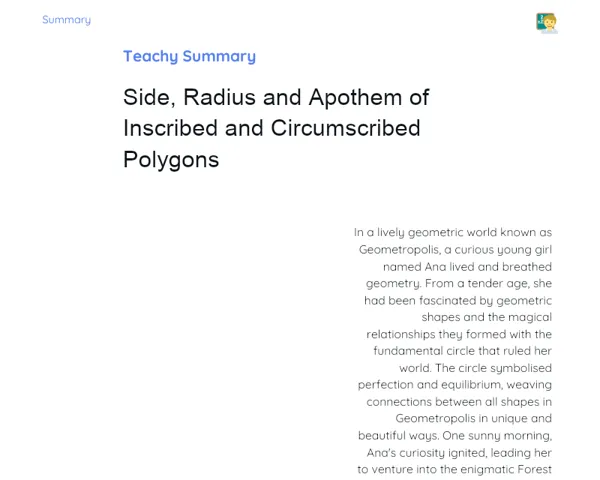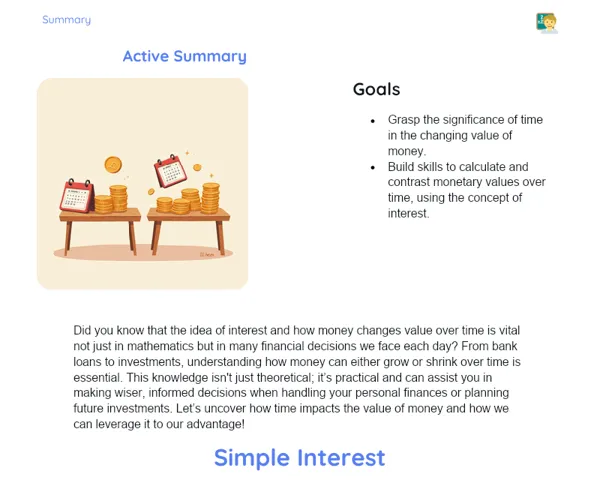Socioemotional Summary Conclusion
Goals
1. Develop the ability to tackle problems involving the calculation of area and volume of solid shapes, like cones 🌠.
2. Apply the Pappus-Guldin theorem to practically calculate volumes and areas of solid shapes 📊.
3. Encourage the recognition and understanding of emotions linked to learning spatial geometry, using the RULER method 🤖❤️.
Contextualization
Have you ever noticed how the objects around us, like an ice cream cone or a fizzy drink can, have such distinct shapes? These shapes are examples of solid figures! Spatial geometry is all around us in fascinating ways, and understanding their properties can empower us to solve real-world problems and innovate 🌟🔍.
Exercising Your Knowledge
Solid Figures
Solid figures are three-dimensional shapes formed by rotating a flat figure (like a triangle or rectangle) around an axis. These shapes include cones, cylinders, and spheres, and are key in various practical applications, from product design to architecture.
-
Generated by rotating flat figures: The rotation of two-dimensional figures creates these three-dimensional shapes. For example, if you spin a right triangle around one of its legs, you get a cone.
-
Used in everyday objects: Solid figures appear in many things we use regularly, like cans, balls, and traffic cones. Knowing about these shapes is essential for solving practical issues, like calculating volumes and areas.
-
Visualisation and modelling: Grasping these shapes helps in visualising three-dimensional spaces and making physical models, which is beneficial in many fields, from engineering to the arts.
Pappus-Guldin Theorem
The Pappus-Guldin theorem is a handy mathematical tool for figuring out the surface area and volume of solid figures. It states that the area of a surface created by the rotation of a flat figure is the product of the circumference of the generating figure and the distance travelled by its centre of mass during the rotation.
-
Area calculation: The theorem makes it easier to calculate the area of surfaces formed by rotating flat figures, which is crucial in engineering and design projects.
-
Volume calculation: It also aids in calculating the volumes of three-dimensional figures, which helps in practical situations, like measuring the capacity of containers.
-
Centre of mass: The distance the centre of mass of the flat figure moves during rotation is a vital part of the theorem, showing the importance of understanding physics alongside maths.
Cone
A cone is a solid figure made by rotating a right triangle around one of its legs. It has a circular base and a point (the vertex) opposite the base. You can find the cone shape in many everyday items.
-
Volume formula: The volume of a cone is calculated using the formula V = (1/3)πr²h, where r is the radius of the base and h is the height. This formula is vital for determining the capacity of conical objects, like cups and funnels.
-
Surface area formula: The surface area of a cone combines the area of the base and the lateral surface area. The formula is A = πr(r + l), where l is the slant height of the cone.
-
Real-world applications: Cones feature in various scenarios, such as in architecture (think conical towers) and nature (like volcanoes). Recognising their properties helps us tackle real-life challenges.
Key Terms
-
Solid Figures: Three-dimensional shapes created by rotating flat figures around an axis.
-
Pappus-Guldin Theorem: A theorem used to calculate the surface area and volume of solid figures.
-
Cone: A solid figure formed by rotating a right triangle around one of its legs.
For Reflection
-
How can understanding solid figures assist you in solving everyday problems? Can you give practical examples?
-
What emotions did you experience while trying to grasp and calculate the volumes and areas of solid figures? How did you manage these feelings during class?
-
In what ways did collaborating in groups support or challenge your learning about spatial geometry? What insights did you gain about teamwork?
Important Conclusions
-
Solid figures, such as cones, cylinders, and spheres, play an essential role in various practical applications and are prevalent in our day-to-day lives.
-
The Pappus-Guldin theorem is an effective tool for calculating the areas and volumes of these shapes, helping us solve real-world problems.
-
Grasping spatial geometry not only supports academic subjects but also aids in everyday situations, such as estimating the capacity of objects and optimising materials.
-
Cultivating socio-emotional skills, like recognising and managing emotions, is critical for personal development and navigating academic challenges.
Impacts on Society
Spatial geometry significantly influences many areas of society, from engineering to product design. For instance, accurately calculating the volume of a fuel tank or the surface area of an object is vital in construction and manufacturing projects. Familiarity with these shapes enables us to improve resource allocation and enhance efficiency across various industrial processes.
Moreover, the ability to solve problems involving solid figures connects to our everyday lives in exciting ways. Picture creating a new product or dreaming up an innovative solution to a problem with your spatial geometry skills! This capability not only ignites your curiosity but can also boost your confidence in tackling complex issues, fostering a sense of accomplishment and personal empowerment.
Dealing with Emotions
To help you navigate your feelings while studying spatial geometry and its applications, let’s try a RULER exercise. First, recognise how you feel when faced with mathematical challenges; it could be anything from frustration to anxiety. Next, understand what triggers those feelings—the challenges of the calculations, perhaps. Clearly name these emotions and find constructive ways to express them, as we discussed in class. Finally, work on regulating those feelings using techniques like deep breathing or taking short breaks. This will help you stay calm and focused during your studies.
Study Tips
-
Make physical models of solid figures with basic materials (like paper, scissors, and glue) to better visualise concepts and reinforce learning.
-
Practice solving various problems involving different solid figures and applications of the Pappus-Guldin theorem. The more you practice, the easier it will become!
-
Form study groups with your mates to discuss problems and swap strategies. Working together can lead to creative solutions and make learning much more enjoyable.



